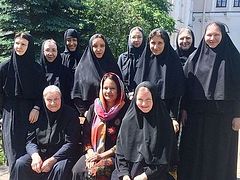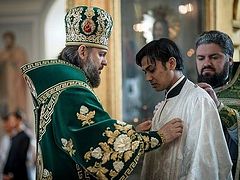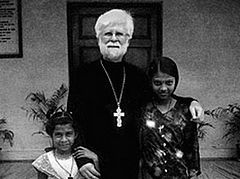The Orthodox presence in India is still insignificant and attracts little attention. It is limited due to the historically weak missionary interest of the Orthodox Church in India, a faraway country which is little known to world Orthodoxy. We offer our readers a short survey of Orthodoxy in India today and an evaluation of the missionary potential in this country.
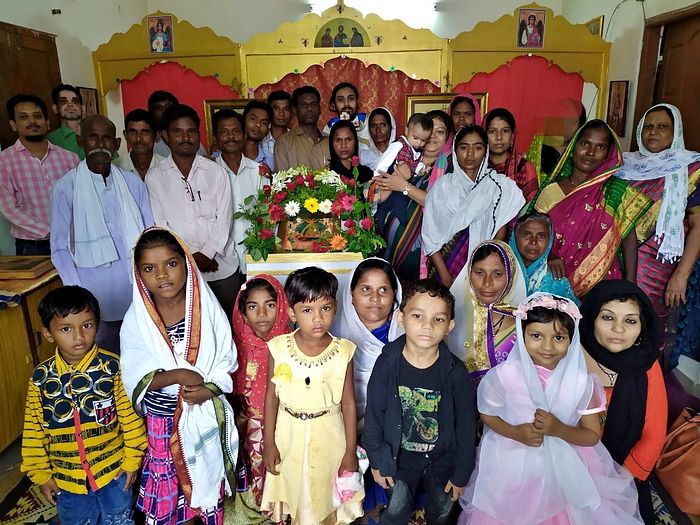 The Holy Trinity house church in Chandrapur, India; the Dormition of the Theotokos, 2019
The Holy Trinity house church in Chandrapur, India; the Dormition of the Theotokos, 2019
The holy Apostle Thomas preached in India in the first century A.D, but as early as the fifth century Indian Christians became Nestorians. The first Catholic missions were set up in this country in the sixteenth century, and these were followed by Anglican and a great number of Protestant missionaries. All of them are still active today. The first Orthodox mission of the Ecumenical Patriarchate was opened at the beginning of the nineteenth century—that is, over 1,300 years after the Indian people had fallen away from the Orthodox Church in the fifth century!
At the present time the Orthodox presence in India can be found in West Bengal, in the district of Chandrapur in Maharashtra state, in New Delhi, and in the states of Goa and Andhra Pradesh. Orthodox missionaries have a desire to open parishes in all the states of India, but it is almost impossible for foreign missionaries to do this under current Indian legislation. It could have been done earlier, but that opportunity was missed. Currently, virtually only citizens of India are permitted to open new parishes and carry out their missionary work more or less freely.
The Greek mission in West Bengal
There is an active Greek Orthodox mission in West Bengal state with its center in Calcutta. Founded in 1812, it was closed in the mid-nineteenth century and was not revived until 1980. The Greek hieromonk, Fr. Athanasios (Antheles), preached with the Bible in his hands, walking from village to village. The preacher died in 1990, leaving twenty-four communities. As of 2004, there were sixteen surviving communities with around 5,000 faithful, ten priests and two deacons. It is known that there were Indians among them. After Fr. Athanasios’s repose, missionary activity shrank. It is confirmed, among other things, by the fact that people from West Bengal, including Calcutta, often appeal to Priest Clement Nehamaiyah, an Indian missionary of the Russian Church (ROCOR), to accept them into the Orthodox Church. There is no cooperation with the Greek mission at present, and prospects for this cooperation in the near future are slim because the Russian Orthodox Church has broken off Eucharistic communion with the Patriarchate of Constantinople. Divisions within the Church considerably lower the power of preaching.
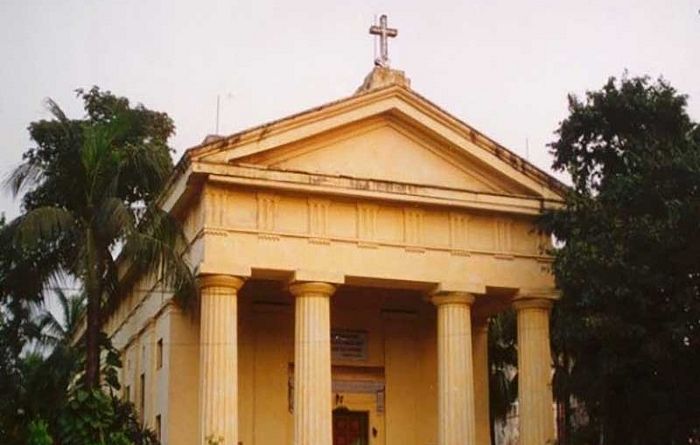 The Church of the Transfiguration of the Lord, Calcutta
The Church of the Transfiguration of the Lord, Calcutta
The Moscow Patriarchate’s parish at the Russian Embassy in New Delhi
There is an Orthodox parish in honor of the Apostle Thomas in New Delhi, the capital city of India. The house church is in one of the rooms of the Russian Embassy in India. The parish was set up thanks to Church and diplomatic efforts of the Russian Orthodox Church with the support of the Russian Government. It is known that the construction of a church on land owned by the Russian Embassy was announced over ten years ago. Construction work has not begun to date, and it can hardly be expected in the near future. Last year the space for the house church was extended at the expense of an adjacent room, and this year an iconostasis is being assembled with funds from donors.
Most of its parishioners are Russians who ended up in India for various reasons. The majority are embassy staff and Russians living in India on a temporary or permanent basis. The first rector who obtained the Indian Government’s permission to reside at the Indian parish permanently was Archpriest Dimitry Kulakov. The main duty of the rector is to give spiritual care to embassy staff, Russian tourists, and the faithful who have their homes in India. Apart from this, the New Delhi church rector makes occasional journeys to Mumbai and Goa, along with Bangladesh and Nepal, to minister to the faithful there.
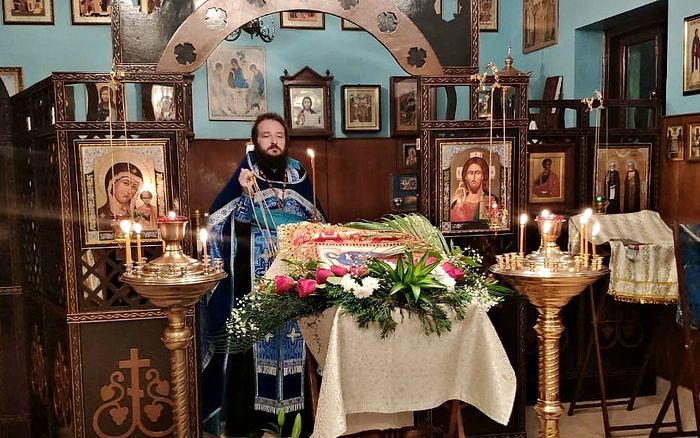 The house Church of St. Thomas at the Russian Embassy in New Delhi
The house Church of St. Thomas at the Russian Embassy in New Delhi
The Orthodox community in Goa
An Orthodox community appeared in Goa in 2013. It caters to Orthodox from different countries, but the majority of them are from Russia. These people ended up in India for a wide range of reasons and strive to live a liturgical life. There is no permanent priest in Goa, and services are only held here when an Orthodox priest visits Goa. At present the community is smaller than it was in 2013. The community wants to build a church, but for now they are unable to do this without permission from the Indian side. It is known that Priest Georgy Maximov pastors this community.
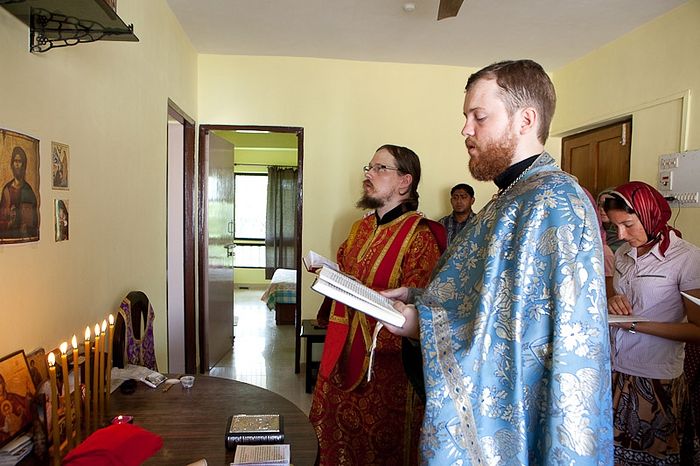 Priest Alexei Zabelin and Deacon Georgy Maximov at a service in the Orthodox community, Goa
Priest Alexei Zabelin and Deacon Georgy Maximov at a service in the Orthodox community, Goa
ROCOR’s mission in Andhra Pradesh
Not long ago, missionary efforts of the Russian Orthodox Church Outside of Russia in the Indian state Andhra Pradesh yielded positive results. The ROCOR priest Fr. Athanasius Kone, rector of the Church of the Iveron icon of the Holy Theotokos in Honolulu, Hawaii, together with Fr. Ephraim from Alaska, visited India in September 2018. Then they continued catechizing Protestants by correspondence. In late January 2019, they visited India again to receive a group of Protestants into the Orthodox Church. It was then that forty-seven Protestant pastors, including Dr. Wesley, and a number of laypeople were baptized into Orthodoxy. It turned out that Dr. Wesley, who had known Fr. Athanasius for decades, had been a distinguished Protestant leader before his Baptism.
The former pastors became laypeople in Orthodoxy and began to serve as church wardens of their communities. At the first stage the success of this mission is stunning. Dozens of Protestants have become Orthodox and they are willing to convert others despite the fact that they have neither services in their native language (Telugu) nor literature, while most believers from among village residents do not know English or any other foreign languages. The ROCOR missionary priests are unable to live in India permanently—for this they need a special visa, and it is extremely difficult to get it. We can only hope that missionaries will make up for the organizational weaknesses and will be able to ensure the mission’s viability by correspondence.
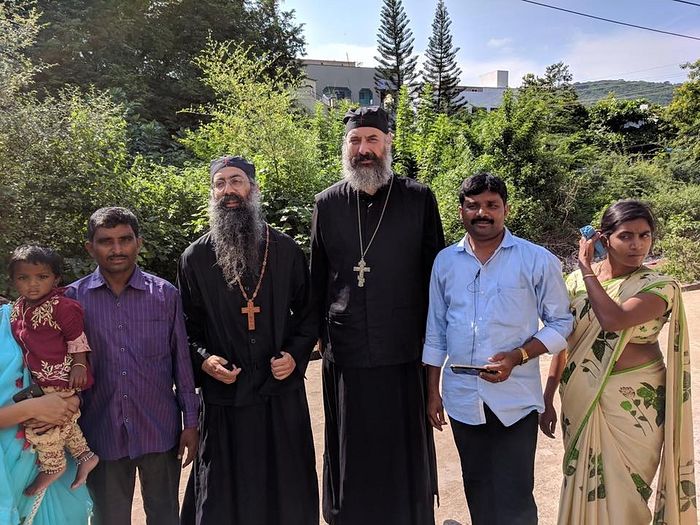 Fr. Athanasius and Fr. Ephraim with the faithful in Andhra Pradesh
Fr. Athanasius and Fr. Ephraim with the faithful in Andhra Pradesh
ROC’s Indian mission with its center in Chandrapur
Fr. Clement Nehamaiyah, a priest of the Russian Orthodox Church, serves in Maharashtra state, situated in the heart of India. He is a native of India and last year he graduated from the St. Petersburg Theological Academy. He speaks fluent Russian.
The history of the Orthodox mission began with a former Anglican bishop, Dr. Polycarp (Rohan) Nehamaiyah, Fr. Clement’s brother. In 2011, this Indian Anglican bishop and missionary firmly decided to embrace Orthodoxy, sending out letters to a number of Local Orthodox Churches. In 2012, the missionary priest Fr. Stanislav Rasputin came from Russia to Chandrapur and received Polycarp together with five Indian communities into the Orthodox Church (around 200 people in all). Polycarp prepared himself for his reception into Orthodoxy thoroughly. Let us cite the words of Priest Georgy Maximov who shared his impressions:
“Over five years ago, he [Policarp.—Auth.], a Protestant by birth, felt that Protestantism lacked fullness. He set about studying Christianity and eventually was convinced that Orthodoxy is the true faith. More than that, he convinced 250 other Protestants of this truth and taught them the Orthodox faith over these years, while trying to reach out to Orthodox Church representatives in the hope of being received… I marvel how people outside the Church can know everything about us so perfectly… It is a real miracle. Not only know, but also sincerely believe in this and wait for the moment when they are received into Orthodoxy.”
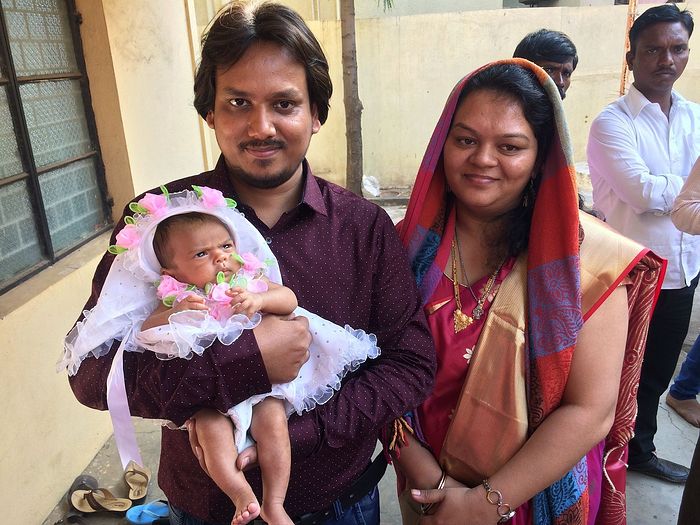 Polycarp with his wife Irene and daughter Xenia. The Baptism of the Lord, 2019)
Polycarp with his wife Irene and daughter Xenia. The Baptism of the Lord, 2019)
In 2013, Metropolitan Hilarion (Kapral) of Eastern America and New York, First Hierarch of the ROCOR, nominated Polycarp for ordination. But although Polycarp was catechized by Archimandrite Oleg (Cherepanin) in Bangkok, he was not ordained. There followed the visits of Russian missionary priests in 2013 and 2014, but the community still had no resident priest. Meanwhile Polycarp, without wasting time, familiarized the community with Orthodox services, taught the ordinary faithful the tenets of the Orthodox faith, making regular journeys to other parishes to serve the typika in his native Marathi.
In 2013, Clement, Polycarp’s brother, went to Russia to study at the St. Petersburg Theological Seminary. However, it was very hard for him to acclimate to a new country, and the doctors almost sent him back to India. In the winter of 2016, Catherine, Clement’s wife, came to St. Petersburg, where Archbishop Ambrose (ex-rector of the St. Petersburg Theological Academy) gave them a Church wedding at the academy church. On the feast of Pentecost, 2018, the academy rector ordained the student from India a priest. In the summer of 2018, Fr. Clement went back to India and embarked on missionary work. But his missionary endeavor had gone on uninterrupted: Over the years of his study at the academy and since his graduation, Fr. Clement has translated the Typika, the Hours, the Liturgy of St. John Chrysostom, the troparia and kontakia of Sundays and the twelve great feasts, the services for the sacraments of confession and Baptism, along with the Great Blessing of Waters into Marathi. The texts are already in use, and they need to be published.
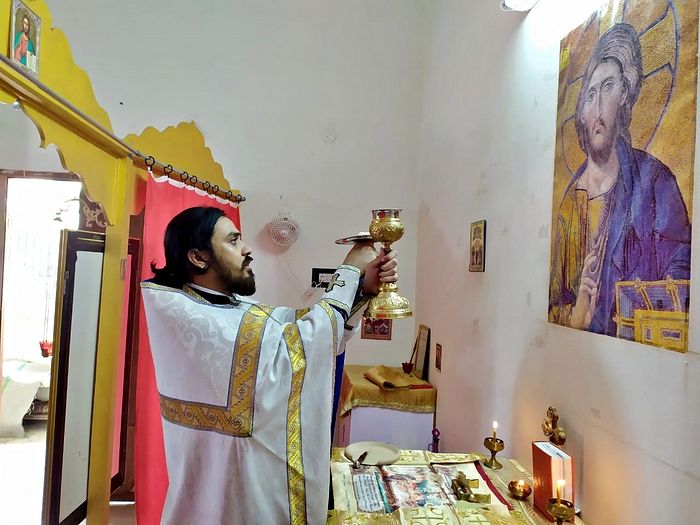 The Divine Liturgy on the feast of the Dormition of the Mother of God, 2019
The Divine Liturgy on the feast of the Dormition of the Mother of God, 2019
Fr. Clement makes missionary journeys almost across the length and breadth of India. He is invited by various Protestant communities that wish to become Orthodox. A large number of the faithful are preparing to join the Orthodox Church. For the heterodox to become Orthodox means making their faith in Christ fuller and receiving the fullness of the gifts of the Holy Spirit. Orthodox mission is being carried out among non-Christians only with great caution, since the Hindu majority in India treats Christians with suspicion.
Presently Fr. Clement Nehamaiyah is doing missionary work thanks to the public support of the Orthodox in Russia. There is a group of public support for the Orthodox mission in India, “The Work of the Apostle Thomas,” on the VKontakte social network and on Facebook, where news and information about the needs of the Indian Orthodox community are published. There is a similar page on Instagram—“Orthodoxindia.” Orthodox Indians lack basic attributes for a fully-fledged religious life: churches, graveyards, and cars for priests to travel to communities.
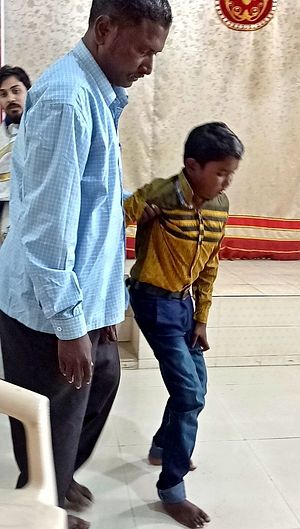 A formerly crippled boy walks to the Liturgy unassisted. The Nativity of Christ, 2019 The Orthodox mission to India is accompanied by miracles of God. Fr. Clement has shared one of these stories:
A formerly crippled boy walks to the Liturgy unassisted. The Nativity of Christ, 2019 The Orthodox mission to India is accompanied by miracles of God. Fr. Clement has shared one of these stories:
“A boy of twelve was crippled by polio. His father brought him to church in his arms as the boy was unable to walk. The parents asked for our prayers. We started praying. But the healing did not occur right away. However, with time the boy got much better. Now he can walk unaided. Both the boy and his parents have been baptized. At first Indian people think that our Lord is one of their numerous deities, then they come to believe that He is the chief God, and finally they come to realize that He is the One God. That is a long process.”
By the example of the history of Orthodox missions in Japan, China, Korea and on the African continent it can be concluded that an Orthodox mission wins the hearts of nations and takes root when natives—instructed in the Church and enlightened by the Holy Spirit—begin to do missionary work themselves. A mission in the mother tongue with knowledge of the local culture is an important and indispensable condition for preaching.
Today the conditions for Indians to acquaint themselves with the Orthodox faith are taking the most favorable turn in the heart of India, namely in the Orthodox community of Chandrapur, Maharashtra state. One of the contributing factors is the fact that unlike their foreign counterparts, Indian citizens do not need special permission for their missionary activity (a “missionary visa”). Sometimes missionaries think, “Since there is an Orthodox parish in New Delhi, there is no problem—anybody will be able to join the Church.” Unfortunately, the activity of the New Delhi parish rector is kept under the surveillance of the Indian authorities, who, as we know, do not encourage the spread of Christianity in the country. Therefore the rector’s scope of activity is very limited.
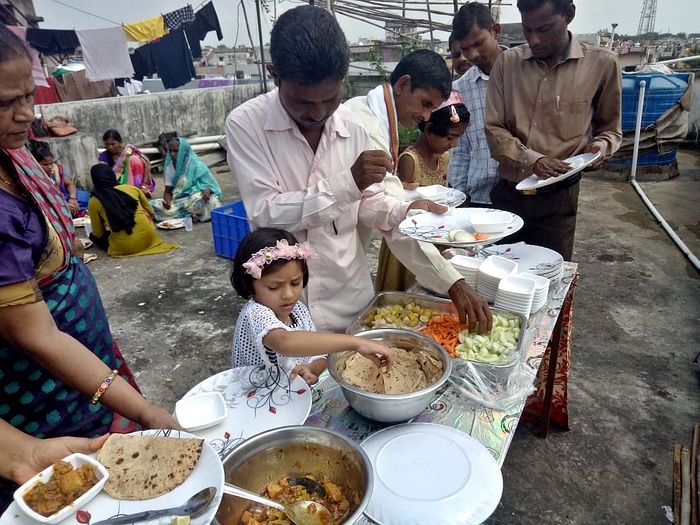 A charitable meal after the Liturgy with donations from Russia
A charitable meal after the Liturgy with donations from Russia
In conclusion we would like to cite the Russian missionary Archimandrite Andronik (Elpidinsky), whose expectations, as we hope, are being fulfilled:
“As has been observed by others, Christianity has not yet secured a worthy place in India. The Catholics build their church by worldly means and keep people in it by the same worldly means. So far we have not heard of any voluntary mass movement towards Christianity anywhere; and we believe there have not been any real missionaries in India so far—those who came here not with their own resources but with the all-powerful blessing and help of God. We presume that will be possible to Holy Orthodoxy alone, provided that India is worthy of this” (Eighteen Years in India, pp. 63-64).

